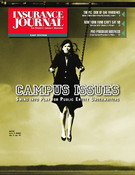New York State employers, increasingly upset over the high cost of workers’ compensation and the lack of response by lawmakers, are stepping up their campaign for legislative action.
A central piece of the employers’ campaign is a new survey in which businesses overwhelmingly say their workers’ comp costs have increased in the last five years, and maintain these costs are limiting employers’ opportunities to grow, hire new workers, and sustain other business investments.
More than a third of respondents to a survey by The Business Council said New York’s workers’ comp costs are encouraging them to consider relocating their business out of state. About one in five respondents said these costs are forcing their businesses to either leave the state or expand elsewhere.
The survey results came a few days before a filing by workers’ comp insurers indicated that coverage might become even more costly soon. The New York Compensation Insurance Rating Board (CIRB) said in a filing with the state insurance department that insurers are looking to increase employers’ average workers’ comp premiums by 29 percent.
“New York’s workers’ comp costs have long been above average by every measure we have seen, and this survey confirms that this difference has very negative consequences for New York’s prosperity,” said Council President Daniel B. Walsh. “Other states have enacted reforms to help contain costs, and we agree with Governor Pataki that it’s time for New York to do the same.”
Walsh said that the 29 percent recommendation from the CIRB is “stunning and frightening” to employers. “It’s stunning because New York State employers already pay workers’ compensation costs that are 72 percent above average on a per-case basis. And it’s frightening because employers need rate relief, not double-digit rate increases.”
The Business Council survey suggests that workers’ comp costs have significant economic implications:
• Virtually all responding employers who compared New York’s comp costs to costs in other states said New York’s costs are significantly (73 percent) or somewhat (20 percent) higher.
• Fifty-nine percent of respondents said workers’ comp costs limit their business growth and expansion. Among respondents with 200 or more employees, 68 percent of respondents said these costs limit growth and expansion.
• Fifty-two percent said these costs prevent them from hiring more workers.
• Fifty-eight percent said these costs require them to scale back other business investments to pay comp costs.
• Thirty-four percent of respondents said these costs are encouraging them to consider relocating the business out of state. Nearly four of 10 respondents with 200 or more employers said these costs encourage them to consider such a move.
• Nineteen percent said these costs are already forcing them to leave the state or expand elsewhere. More than one of four employers with 200 or more employees said these costs are having this effect.
Gov. George Pataki announced a reform proposal in March in Albany. He said his plan would cut employers’ costs by 15 percent while raising maximum benefits by 25 percent. That reform package, which The Business Council is supporting, has been introduced in the Senate (S. 6841-Rules).
Business groups and the insurance industry have also been pushing for years for changes in the so-called scaffold law, sections 240 and 241 of the Labor Law, which they say contributes to the state’s worsening workers’ comp environment. This law makes owners, contractors and subcontractors absolutely liable for worksite injuries regardless of worksite safety programs, employee negligence or any other factors in the injury. No other state imposes such absolute liability in these cases.
Contractors and insurers say the law in the last five years has driven insurances costs up, in some cases by a factor of 10. In fact, some contractors, especially upstate, have reported being unable to get general liability insurance at any cost because of this law, according to the Business Council.
A bill sponsored by Assemblyman Joseph Morelle’s (A. 7213/S. 1710) would change the absolute liability standard to one of contributory negligence for employers that provide approprivate safety training and equipment. The Business Council and its affiliate, the Construction Industry Council, have long sought such a reform.
“This bill would introduce a simple element of fairness into these cases: It would permit defendants to defend themselves,” said Walsh.
While previous attempts to amend the scaffold law have stalled, Morelle appears determined to at least get lawmakers’ to vote on the record on the issue this session. Morelle made a procedural move that will force the Assembly Labor Committee to vote on it before the end of the legislative session.
The chair of the Assembly Labor Committee, Susan John (D-Rochester), asked Morelle to withdraw his motion, but he declined, Morelle told the New York Sun. Morelle told the Sun he was forcing the vote “because that’s what you get elected to do.” He added: “I think it’s important enough. . . . In the Rochester area in particular, literally hundreds of jobs are at risk.”
The insurance industry also backs the bill, which is sponsored in the Senate by Sen. Dale Volker (D-Erie County).
Walsh is adamant about the need for lawmakers to act. “California has finally acted to address its workers’ comp nightmare. New York must do the same—and must ease other costs of job creation so businesses, not taxpayers, can once again be New York’s main source of job creation,” he said.
A recent Business Council report expressed the frustration of employers: “New York already has the second-highest average claim cost in the nation. We already have comp rates that are eighth-highest in the nation, $31.30 per $1,000 of payroll. We’re one of only nine states in the country without a limit on how long an injured worker can collect benefits for a partial disability.” New York is also one of only four states that does not require the use of objective medical guidelines when determining a disability, the report notes.
New York’s cost of doing business is already far too high, the report added. “Yet the state Legislature continues its pattern of inaction—or worse yet, raises fees and taxes— but wonders why our economy is struggling and jobs are being sent elsewhere.”
In the matter of the 29 percent rate filing, just because the industry has requested a 29 percent hike does not mean it will happen. Last year, the department rejected two increases proposed by CIRB, 11.2 percent and 2.7 percent, before increasing rates by 1.7 percent. The department last year also approved a 10 percent increase in the assessment rate, raising it from 13 percent to 14.3 percent.
The National Council on Compensation Insurance (NCCI) in September 2003 estimated that the average cost of a workers’ comp case in New York was $11,793, 72 percent above the national average. New York’s costs are above average mainly because the state offers lifetime benefits in cases in which benefits are not “scheduled” in state statute. These cases account for 14 percent of claims, but more than 77 percent of all compensated injuries.
Was this article valuable?
Here are more articles you may enjoy.


 Aon Adds to List of Brokers Suing Howden US for Alleged Poaching, Theft
Aon Adds to List of Brokers Suing Howden US for Alleged Poaching, Theft  Three Top P/C Insurers Account for Most of Insurance AI Patents
Three Top P/C Insurers Account for Most of Insurance AI Patents  Cessna Jet Tied to Nascar Driver Greg Biffle Crashes in North Carolina
Cessna Jet Tied to Nascar Driver Greg Biffle Crashes in North Carolina  Tesla Door Safety Issues Have Owners Buying Car Escape Tools
Tesla Door Safety Issues Have Owners Buying Car Escape Tools 


